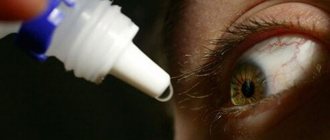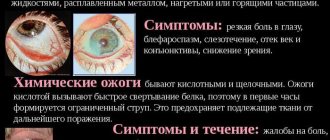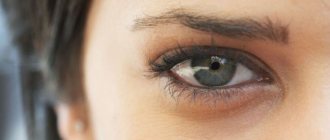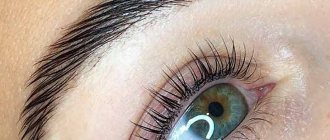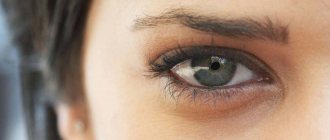If oil gets into your eye, what should you do? The problem may arise unexpectedly and requires an urgent solution, otherwise serious complications may develop.
How can you help yourself or someone else in such a situation, what is strictly prohibited to do, and is it always necessary to go to an ophthalmologist? Let's consider these and other questions in detail in the article.
Oil gets into the eye: consequences and symptoms
What sensations a person will have when oil gets into the eye, and how this can affect vision, depends on the type of specific product and its temperature.
In any case, it is perceived by the body as a foreign body. A film forms on the mucous membrane or cornea, preventing normal vision. There is pain, discomfort, it is difficult to blink, tears begin to flow. The situation gets worse if the essential oil is caustic. The aromatic substances in its composition provoke increased lacrimation and increase pain, cause a burning sensation and can lead to chemical burns of the cornea. The more pungent the components are present, the more severe the oil burn to the eye may be.
Products with hot peppers are especially dangerous. Mixtures with extracts of grape and apricot seeds, almonds and peach, burdock and castor create fewer problems. The mildest option is when sunflower or olive oil gets into your eyes.
But if the substance is hot, for example, oil from a frying pan gets into the eye,
the situation is getting worse. Thermal burn of the cornea in this case is inevitable, which can lead to adverse consequences. Therefore, if a hot drop gets into your eye, you need to act especially quickly.
Symptoms of injury
Oil is a thick liquid with a high boiling point. When it comes into contact with the mucous membrane or cornea of the eye, it forms a film there that causes visual impairment. Due to its high density, the oily liquid acts as a foreign body. It causes pain in the eyeball, a feeling of discomfort, difficulty blinking, and increased lacrimation. This applies to any type of oil.
Some types of oily liquids are particularly aggressive; if they come into contact with the cornea, they are accompanied by pronounced symptoms.
- For example, if essential oils get into the eyes, a person experiences severe pain, burning, and increased lacrimation. The victim has difficulty opening his eyelids, and photophobia appears. The aromatic essential oil is always highly concentrated, and the cornea has many nerve endings, which is why such manifestations occur.
- If a drop of burdock oil gets into your eyes, the symptoms will be almost the same. This product is usually used for cosmetic purposes and almost always contains some kind of additive.
- Contact with red pepper extract is especially dangerous - it leads to severe burns of the mucous membrane.
- Among other cosmetics, grape, apricot seed extracts, almond and peach oils are considered less dangerous. They cause a slight burning sensation that quickly disappears.
- What happens if castor oil gets into your eyes? This type is considered less dangerous, however, it can also cause an irritating effect in the form of a burning sensation with lacrimation.
The safest is ordinary vegetable oil - if it gets on the cornea, it will only cause blurred vision and discomfort.
Possible complications
Burns, chemical or thermal, caused by oily substances can lead to very serious consequences and provoke complications.
- The eyelids can be deformed by scars, which disrupts the aesthetics of the face.
- The range of eyelid opening may decrease.
- Eyelashes may begin to grow incorrectly.
- Clouding of the cornea may occur, which can cause partial loss of vision. Cloudy areas do not allow light to pass through, causing the picture to be perceived distortedly.
- A severe complication is fusion of the upper and lower eyelids.
- Dry eye syndrome may develop. This phenomenon is familiar to those who spend a lot of time working on a computer.
- The ducts through which tears come out may become narrowed or blocked. This is fraught with the development of inflammation, because the tear fluid will accumulate, and unfavorable processes will begin in it.
- Chronic inflammation can develop in the eye structures.
- It is possible to develop glaucoma, a disease in which intraocular pressure increases. And this, in turn, leads to the fact that the optic nerve and retina gradually die. The most severe consequence of glaucoma is complete blindness.
- A dangerous complication that can occur if hot oil is splashed into the eye is cataract, clouding of the lens. A person begins to see his surroundings as if through streams of water. Over time, visual abilities decrease.
Chemical burns to the eyes with burdock oil
Ophthalmologist of the Department of Microsurgery No. 2 Kuzmitskaya L.N.
Recently, traditional methods of treatment and self-care have become increasingly popular among the population. They do not always turn out to be useful and safe. In our practice in the emergency room of ophthalmology, we were faced with the consequences of using such a well-known remedy as burdock oil. Burdock oil is obtained from the roots of different types of burdock plants in the first and second years of life.
Chemical composition:
Burdock oil contains the natural polysaccharide inulin (up to 45%), protein substances (about 12.34%), sieve-sterol, essential oils (up to 0.17%), fatty acids (palmitic and stearic), tannins, bitterness ( about 20%), mineral salts and vitamins C (up to 350 mg%), A, E, group B), flavonoids and some other substances.
Application: Burdock oil is used both internally and externally for the prevention and treatment of many diseases:
- For mastopathy (breast lubrication).
- For radiculitis.
- For the treatment of old non-healing wounds, eczema and other skin diseases.
- For acne.
- For hair care (thinning hair, loss of shine, fragility, splitting at the ends, hair loss, slow growth, dry seborrhea), with sparse thin, invisible eyelashes.
- To strengthen nails.
- For skin care. Burdock oil is used before taking a bath.
Burdock oil is useful for people of any age as a preventative, cleansing and rejuvenating agent. It helps strengthen hair roots, stimulates their growth, prevents hair loss, irritation, itching, dry scalp and eliminates seborrhea, normalizes hair structure, restoring split ends, giving it shine and elasticity.
Recently, thanks to advertising of the beneficial properties of burdock oil, its use for strengthening and growing eyelashes has become increasingly widespread among the masses. At the same time, in pursuit of the “effect of lush eyelashes,” female representatives neglect the precautions indicated on the label of any jar of the product, which states that oil should not come into contact with the mucous membrane of the eyes. As a result, an undesirable reaction occurs: instead of beautiful eyelashes, you get eye burns.
Clinic
Complaints usually do not appear immediately, but 2-3 hours after using burdock oil, sometimes in the morning after sleep. Sometimes symptoms do not develop immediately, but after repeated periodic use of the oil, when there is a constant effect of substances on the mucous membrane of the eye with the development of an inflammatory process in it.
When contacting an ophthalmologist, patients complain of decreased vision, redness of the eyes, photophobia, lacrimation, from moderate discomfort and a feeling of sand in the eyes to severe pain and severe pain.
The typical clinical picture includes swelling of the eyelids, photophobia, lacrimation, blepharospasm, and hyperemia of the eyeballs. During eye biomicroscopy in the emergency ophthalmologic care office, we detect signs of burn damage of varying severity: mixed injection of the eyeball, conjunctival edema and corneal edema, pinpoint areas of de-epithelialization of the cornea or extensive eroded surfaces of the cornea, stained with fluorescein. In terms of distribution, such burns most often correspond to I and II degrees. All changes are caused by the damaging effects of the acid contained in burdock oil.
In addition, burdock oil contains essential oils that have high biological and sensitizing activity, due to which they cause severe allergic reactions when they come into contact with mucous membranes. Therefore, you should not allow these substances to get into your eyes, much less use them to improve eyelash growth by rubbing burdock oil deep at the roots of the eyelashes, thus pushing the active substances into the conjunctival cavity.
Treatment
If burdock oil gets into your eyes, you should immediately rinse them thoroughly under running water or furacillin solution and consult an ophthalmologist. Treatment is usually local and involves the use of eye drops. Instillations of antibacterial drops (tobramycin, ciprofloxacin) are used to prevent the development of infectious complications and anti-inflammatory drugs (diclofenac, nevanac) to reduce pain. The use of anesthetics (tetracaine, lidocaine) is undesirable due to slower healing of wound surfaces. Their short-term use is allowed for severe eye pain. Also undesirable is long-term use of steroid drugs (dexamethasone), which reduce the inflammatory reaction and tissue swelling, but at the same time reduce local immunity and the reparative ability of tissues. To improve the healing process, trophic and vitamin drops (sevitin, taufon, emoxipin, vitamin A oil solution) and reparants (solcoseryl gel, corneregel) are necessarily prescribed.
The duration of treatment averages from 5 to 10 days; the use of vitamin drops is recommended to be continued for up to several weeks. With timely and correct treatment, complications, as a rule, are not observed and regeneration of the ocular surface occurs quickly within a few days with complete restoration of vision. However, it is necessary to remember the possible consequences and complications, such as keratitis, corneal opacities, keratopathy, dry eye syndrome, and use various biologically active cosmetics with caution.
First aid
When oil gets into your eye, what should you do first? Ophthalmologists talk about emergency measures.
- Immediately rinse the eyeball with clean water. This must be done according to the rules. First, clean boiled water at room temperature is poured into a saucer. Then they bend over so that the eyeball touches the water. Blink several times until the foreign substance is washed away. The process should be continued for 10-20 minutes to thoroughly rinse off the residue. Some doctors recommend that if substances containing esters come into contact, first use olive and corn mixtures for rinsing.
- Apply eye drops if you have them in your first aid kit. Albucid or boric acid are suitable. No more drops or ointments should be used until examined by a doctor.
- If the tissue is burned, use a cold compress, such as gauze or a chilled tea bag. This will help reduce tissue temperature, which means minimizing possible complications.
- Apply a sterile bandage. Secure it with adhesive tape.
Do not rub the affected area: this will only worsen the situation.
Another rule: if there is something else on the mucous membrane, for example, flour, washing powder, etc., the first thing you need to do is remove them using a clean napkin. Only after this proceed to washing.
What to do next if oil gets into your eye?
Even if the symptoms have subsided, you should consult a doctor as soon as possible. The ophthalmologist will carefully examine the organ, remove any remaining foreign substance, and if necessary, instill an anesthetic.
It is necessary to go to the doctor in the following cases:
- if the victim is a child;
- when the pain is very severe;
- if the ability to see has sharply decreased;
- when the patient sees dark spots in the central part of the visual field;
- when looking at shiny objects, rainbow circles or a rainbow are seen;
- Pain is felt behind the eyeball, and it intensifies with its movements.
It is necessary to contact an ophthalmologist if any foreign body enters. Even if you do not feel discomfort after the injury, or it is minor, it is better to get examined and make sure that everything is in order.
Hot oil splashed into the eye: first aid
Hot air or steam, sparks from welding equipment, hot liquid, sharp splashes of hot oil from a frying pan can cause eye burns. Thermal burns are typically mild because exposure to extreme heat sources stimulates reflex blinking, which allows the eyelid to protect the surface of the eye.
In the case of hot oil, it has time to cool a little during its flight, but can still cause problems such as blurred vision and pain.
In general, any eye injury requires the intervention of a specialist - an ophthalmologist. Therefore, your main concern is to protect the injured eye until you receive medical attention.
Thermal burns tend to affect the eyelid more than the conjunctiva or cornea. Thanks to the high reflex ability of blinking, the eyelids protect the eyes. If, nevertheless, a drop of oil gets into the eye, it is better if it gets on the white and not on the cornea, this will create much less problems with vision.
Symptoms:
- Pain in the eyeballs
- Burning eyelids
- Erythema (redness of the skin)
- Photophobia and lacrimation that occurs several hours after injury
- Blurred vision
What you can do in case of a burn:
- You should not rub your eyes because this will make the situation worse!
- Stop the harmful factor as quickly as possible.
- Burns to the surrounding structures of the eye (eyebrows and eyelashes) are not uncommon. First aid for a burn of the eyelid can be a cold compress on closed eyes and a cream on the eyelids such as pantestin.
- Glasses with dark filters.
- If oil gets into your eye, you will see blurry; from personal experience, eye drops - Visine - helped reduce blurriness. Also, the blurriness goes away a few hours after the burn if the injury is not serious.
Be sure to consult an eye doctor if you experience any of the following symptoms, even if you are not injured:
- Sudden decrease in visual acuity.
- The appearance of dark spots in the center of the visual field or restrictions on the periphery similar to the appearance of a “curtain”.
- Sharp pain in the eyeball, often combined with headache on one side.
- The appearance of circles or rainbow rays when looking at shiny objects.
- Pain behind the eyeball, which increases with movement.
This information is provided for informational purposes only. For advice regarding diagnosis and treatment, contact the appropriate specialist!
Prevention measures
To prevent various substances from getting on the eyeball, it is recommended to take precautions.
- Carefully perform cosmetic procedures that use oil compositions.
- Don't lean over the frying pan when something is frying.
- Wash your hands thoroughly when preparing food and do not rub your face with dirty fingers.
We told you what to do if oil gets into your eye. The main thing is not to get confused and take action right away. And then go to the doctor to undergo subsequent treatment and avoid serious complications.
Video:
